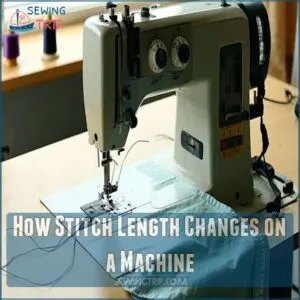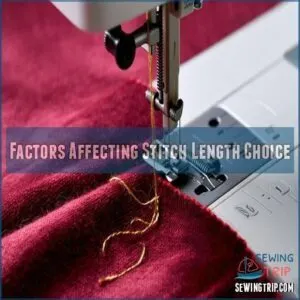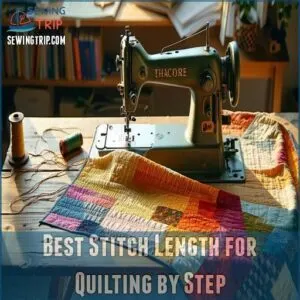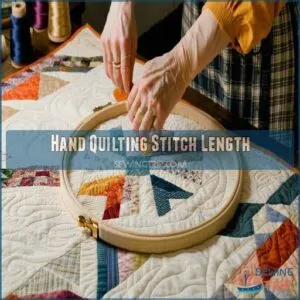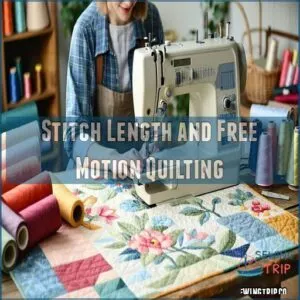This site is supported by our readers. We may earn a commission, at no cost to you, if you purchase through links.
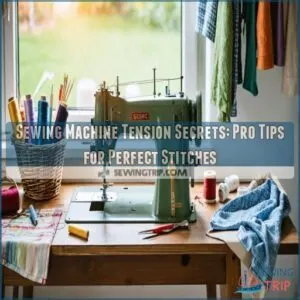 Ready to master your sewing machine’s tension? Think of tension as your fabric’s best friend, controlling how threads interlock like a precise dance.
Ready to master your sewing machine’s tension? Think of tension as your fabric’s best friend, controlling how threads interlock like a precise dance.
Your ultimate sewing machine tension guide starts with understanding your machine’s personality. Adjust the tension dial clockwise for tighter stitches and counterclockwise for looser ones.
Always match your needle size and thread to your fabric type – it’s like picking the perfect dance partner.
Clean your bobbin area regularly and double-check threading to prevent tension tantrums. Pro tip: test your settings on scrap fabric first.
By fine-tuning these elements, you’ll transform potential stitch disasters into seamless, professional-looking creations that’ll make your projects sing.
Table Of Contents
Key Takeaways
- You’ll master machine tension by understanding your dial: turning clockwise tightens stitches, counterclockwise loosens them, so experiment carefully on scrap fabric.
- Your fabric type dictates tension settings, so match your needle size, thread weight, and machine tension to create professional-looking stitches that won’t pucker or break.
- Test your tension sweet spot by checking both sides of your fabric – ideal settings create even, flat stitches without visible loops, typically around 4-5 on most machines.
- Regular machine maintenance like cleaning your bobbin area, using quality threads, and rethreading when issues arise will help you consistently achieve perfect stitch tension.
What is Stitch Length?
When you first get into quilting, stitch length might seem like a minor detail, but it’s the secret sauce that transforms good projects into great ones.
Think of stitch length as the DNA of your sewing project – it’s the precise distance between each needle punch that can make or break your fabric’s look and feel. Your sewing machine‘s tension and stitch control directly impact how those stitches sit on different fabrics.
Understanding the stitch length mechanism is essential for achieving perfect stitches. Thicker materials need longer stitches to prevent bunching, while delicate fabrics demand shorter, more delicate touches.
The right needle size and thread type can dramatically influence your stitch quality. Pro tip: experiment with your machine’s settings to find that sweet spot where your stitches look clean, consistent, and professional.
Why Not Go as Short as Possible?
Mastering stitch length isn’t about cramming the tiniest stitches possible into every project. Sure, short stitches seem secure, but they’ve got hidden pitfalls that can derail your sewing success. Think of stitch length like a secret recipe – too much of one ingredient throws everything off balance.
Understanding the sewing machine stitch length is essential for achieving professional results. Extremely short stitches can lead to thread breakage, fabric distortion, and tension nightmares.
They’ll make your fabric stiff, restrict your sewing speed, and create visible lines that scream "amateur hour" on delicate projects. Free motion quilting becomes a wrestling match when your stitches are too tiny. Your sewing machine tension guide isn’t about extreme measurements – it’s about finding that sweet spot where function meets finesse.
Sometimes longer stitches give you more breathing room and creative control.
How Stitch Length Changes on a Machine
Ever wondered how your sewing machine magically transforms stitch length? Let’s unpack the mechanics behind this fabric-transforming wizardry. The stitch length dial isn’t just a random knob – it’s your precision tool for sewing machine tension control.
Understanding the stitch length basics is vital for achieving perfect stitches on various fabrics.
- Feed Dog Magic: These tiny metal teeth move fabric with mathematical precision
- Dial Dynamics: Adjusting the dial changes stitch distance microscopically
- Thread Control: Each movement impacts fabric density and stitch appearance
- Calibration Secrets: Understand your machine’s unique rhythm for perfect stitches
Your machine’s internal dance of mechanics makes certain every stitch lands just right.
Factors Affecting Stitch Length Choice
When you’re choosing stitch lengths, you’re not just picking a random number on your machine’s dial—you’re making a strategic decision that impacts your project’s strength, appearance, and durability.
Every fabric type, sewing technique, and project goal demands a specific stitch length that’ll make or break your final creation.
Visibility in Quilts
Every quilt tells a story, and your stitch visibility can make or break that narrative.
When choosing stitch length, consider how each thread will pop against your fabric’s landscape.
Shorter stitches might vanish into delicate jersey, while longer ones could create dramatic texture on materials.
Thread colors and stitch density play pivotal roles in revealing your quilt’s design. Your sewing machine tension guide becomes your paintbrush, transforming fabric choices into visual poetry that speaks volumes without uttering a word.
Structural Vs. Aesthetic Stitches
Balancing structural and aesthetic stitches means choosing stitch length wisely.
Structural stitches prioritize seam strength and fabric durability, requiring tighter sewing machine tension for lasting hold.
Aesthetic stitches, like decorative quilting, spotlight thread visibility and appeal, calling for adjusted tension to maintain stitch quality.
Use a thread tension guide to balance both, ensuring perfect stitch tension and flawless sewing tension control.
Choosing Stitch Lengths
Picking the right stitch length is like customizing your sewing blueprint—it shapes your project’s look and strength. Understanding the effects of sewing machine stitches is essential for achieving perfect stitches.
Keep these in mind:
- Fabric thickness: Thicker fabrics need longer stitches.
- Thread weight: Thicker threads pair with longer stitches.
- Sewing speed: Faster speeds benefit from slightly longer stitches.
- Tension balance: Adjust tension to match stitches.
- Sewing machine settings: Always test on scraps first!
Best Stitch Length for Quilting by Step
Choosing the right stitch length for quilting depends on the technique you’re using and the results you want.
From securing layers with basting stitches to creating stunning free-motion designs, adjusting your stitch length step-by-step can make all the difference.
Machine Quilting/Walking Foot
Mastering machine quilting with a walking foot means nailing your sewing machine tension and stitch length.
A walking foot guarantees even feeding, essential for dense layers or slippery fabrics. Set your stitch length to around 2.5–3.0 for smooth, balanced stitches.
Keep the foot pressure right to avoid puckering, and test on scraps to perfect thread control.
Use this quick cheat sheet:
| Setting | Ideal Range | Why It Matters | Test Tip |
|---|---|---|---|
| Stitch Length | 2.5–3.0 mm | Balanced stitches | Test on quilt scraps |
| Thread Tension | Medium (4–5) |
Traditional Piecing
Ensuring strong, polished blocks in traditional piecing starts with the right stitch length. For most quilts, 2.5 is your sweet spot—strong, neat, and not too obvious.
Here’s why it works:
- Fabric selection stays secure without fraying.
- Seam allowance holds firmly during quilt assembly.
- Neat stitches enhance block construction.
- Balanced thread and bobbin tension guarantee smooth piecing techniques.
Foundation Paper Piecing
When tackling foundation paper piecing, precision is your best friend. The right stitch length guarantees smooth block construction and easy paper removal.
Here’s a quick guide:
- Start with 1.5-2: This length secures seams yet lets paper tear off cleanly.
- Go smaller for details (1.2): Tiny sections love tighter stitch lengths.
- Mind your speed: Steady sewing protects your fabric and keeps seam allowances neat.
Basting Seams
For basting seams, a stitch length of 4 is your go-to—a bit longer, like a gentle handshake, offering just enough grip without overstaying its welcome.
Whether securing seam allowances or keeping quilt blocks in check, it’s all about temporary hold. Machine or hand basting? Both work wonders.
Remember, sewing thread tension plays a role—balance it right. Quick tip: longer stitches mean easy removal later, so no wrestling required!
Understanding basting stitch techniques is essential for achieving professional results.
| Category | Recommendation |
|---|---|
| Stitch Length | 4 |
| Thread Tension | Adjust for fabric |
| Technique | Machine or hand basting |
| Purpose | Temporary hold |
| Ease of Removal | Easy with longer stitches |
Free Motion Quilting
Free motion quilting puts you in control—think of it as drawing with thread.
Lower the feed dogs and focus on smooth, even movements.
Use quilting techniques like tension setting tips to balance sewing machine tension, including thread and bobbin tension adjustments.
Mastering machine quilting techniques is essential for achieving professional-looking results.
Experiment with fabric selection, thread choices, and quilt designs on scrap fabrics to perfect your masterpiece.
Hand Quilting Stitch Length
Needle dancing across fabric tells a story of craftsmanship in hand quilting. Your stitch length becomes the silent narrator of your quilting journey, revealing intricate details with every pass.
Here’s what you need to know about mastering hand quilting stitches:
- Aim for a sweet spot of 3.5 stitch length to showcase your handiwork beautifully
- Match your stitch length to fabric weight – thinner fabrics need delicate touches
- Consider your quilting purpose: structural support or pure artistic expression
Proper thread tension control is essential to achieving consistent stitches. Thread tension and stitch control are your secret weapons. By understanding these nuanced techniques, you’ll transform simple stitches into a textile masterpiece that speaks volumes about your skill and passion.
Stitch Length and Free Motion Quilting
Unleashing creativity through free motion quilting means taking total control of your stitch length. Unlike traditional machine quilting, you’ll guide your fabric’s movement manually, dictating each stitch’s rhythm and flow.
Your sewing technique becomes a dance between machine settings and personal touch, where thread tension adjustment plays a vital role. Understanding the stitch length mechanism is essential for achieving perfect stitches.
Experiment with different quilting speeds and fabric thicknesses to find your sweet spot. Pay attention to how sewing machine tension impacts stitch quality – too tight, and you’ll create stiff, unyielding lines; too loose, and your design loses definition.
Remember, mastering free motion quilting is about embracing imperfection and letting your artistic instincts guide the needle. It’s less about precision and more about expressing your unique quilting voice.
Frequently Asked Questions (FAQs)
What should my sewing machine tension be set at?
Picture threading through fabric like a pro: your sewing machine tension typically sits around 4-
But hey, your fabric’s personality matters—test, adjust, and watch those stitches transform from wonky to wow!
How to know what tension to use?
Check your fabric type first.
Start at a medium tension (4-5), then test on scrap fabric.
Look for balanced stitches without loops or puckering.
Adjust tension dial incrementally until your stitches look perfect and smooth.
What stitch length and tension should I use?
Adjust your stitch length to 5-0 for most fabrics.
Dial in tension between 4-5 for balanced stitches.
Lighter fabrics need lower tension (2-3), heavier materials require slightly higher settings (5-6).
Test on scrap fabric first.
What is perfect stitch tension?
Thread tension’s the secret sauce of sewing!
Your perfect stitch tension balances upper and lower threads, creating even, flat stitches without loops.
Aim for a 4-5 setting, but test on scrap fabric to nail your unique machine’s sweet spot.
How does tension affect stitch length?
Tension impacts your stitch length like a puppet master pulling strings.
Tighter tension shortens stitches, while looser tension lets them stretch out.
Your machine’s tension dial controls this delicate dance of threads.
What is the ideal tension for a straight stitch?
You’ll want your straight stitch to lay flat and even on both sides.
Aim for a balanced tension around 4-5, where the stitches look clean and uniform without visible loops or puckering on either fabric surface.
How does the type of fabric affect thread tension?
Ever wondered why your stitches look different on various fabrics?
Different fabric weights demand unique tension settings.
Silk needs lower tension, denim requires higher.
Match your machine’s tension to your fabric type for perfect, professional-looking stitches every time.
What are the common causes of thread tension issues?
Tension troubles often stem from improper threading, dull needles, low-quality threads, incorrect bobbin installation, lint buildup, and mismatched thread types.
Careful maintenance and precise setup can solve most sewing machine tension headaches.
How does the needle type influence thread tension?
Like a precision instrument, your needle’s size and type are the conductors of thread tension.
Sharper needles glide smoother, while larger needles create more thread friction, subtly shifting your machine’s tension balance with each stitch, acting like conductors.
How do I know if my machine needs rethreading?
If your stitches look wonky, threads are looping, or you’re experiencing weird tension issues, it’s time to break out the manual and rethread your machine from scratch.
Your fabric will thank you later.
Conclusion
Mastering your sewing machine’s tension is like tuning a musical instrument—each adjustment harmonizes your stitches.
Your ultimate sewing machine tension guide isn’t just about mechanics; it’s about confidence.
With practice, you’ll transform potential stitch nightmares into professional-looking creations.
Remember, tension is a skill that improves with patience and experimentation.
Trust your machine, trust yourself, and watch your sewing projects come to life with precision and style.
- https://www.sewdirect.com/blog/great-british-sewing-bee-blog/how-to-sew-fleece-fabrics/
- https://sewingmachinebuffs.com/ultimate-sewing-machine-tension-guide/
- https://www.stitchtips.com/what-should-my-sewing-machine-tension-be/
- https://www.eharrisgallery.com/sewing-machine-tension-chart/
- https://sewingtrip.com/ultimate-sewing-machine-tension-guide/

